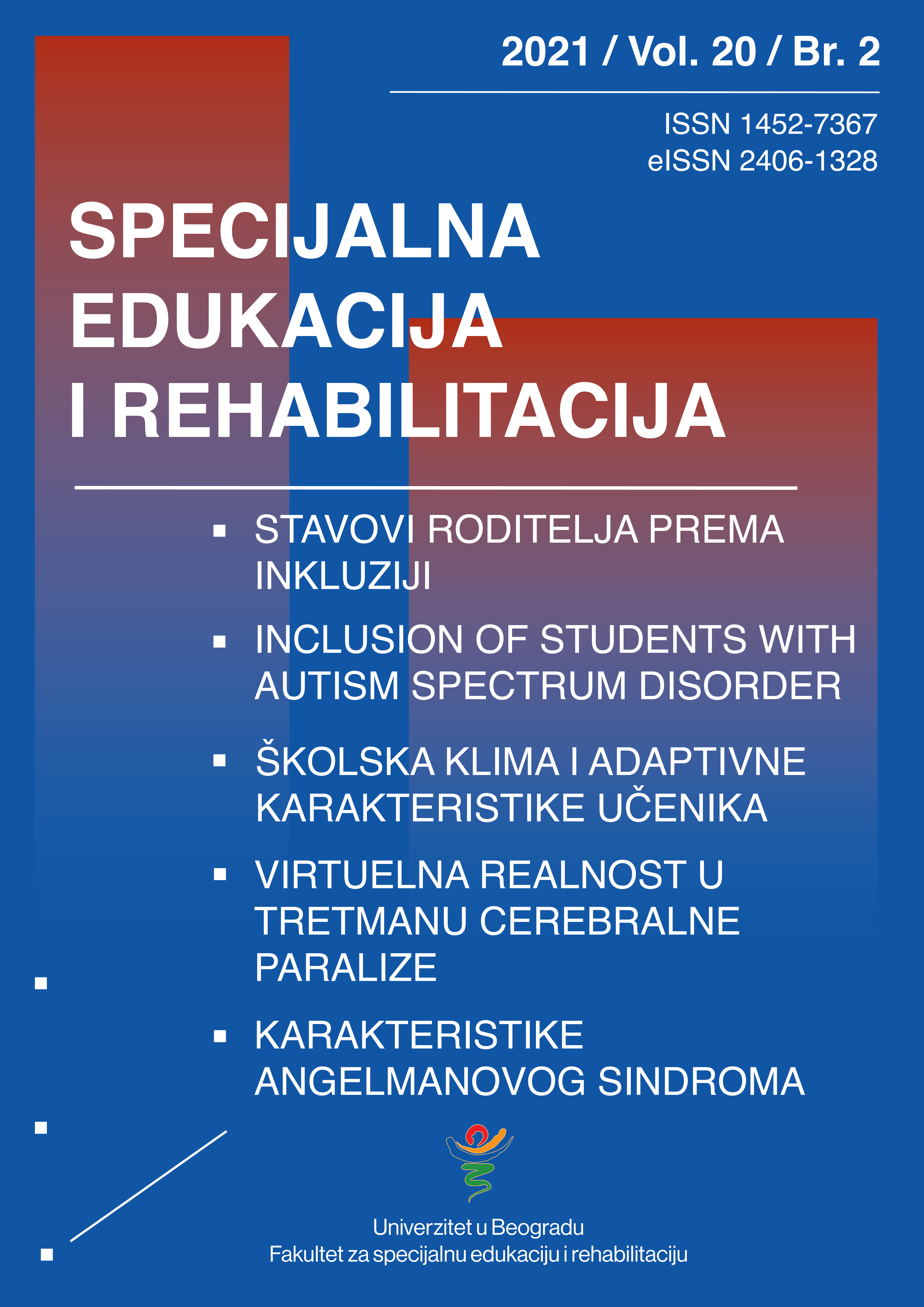Inclusion of students with autism spectrum disorder in the Jordanian regular classrooms: Teachers’ perspectives
Abstract
Introduction. This study focuses on the relevance of inclusion for students with autism spectrum disorder (ASD) in the regular classroom. This issue has achieved international recognition with recommendations in most countries that the students should be given the same opportunities as those without disabilities. The case of Jordanian teachers in Amman is selected in this study. Objectives. It specifically aims at investigating the teachers’ perspectives on inclusion of students with ASD in Jordanian regular classrooms. Methods. The issue is evaluated using a qualitative study design where nine teachers were interviewed virtually. Results. The findings indicated the need for better training and skills development in specific aspects and needs of students with ASD. Providing teachers with training as well as materials and financial support is necessary for supporting inclusive learning. The teachers also report significant limitations in how inclusion of ASD students is supported in Jordan. The perspectives towards inclusion of ASD students in Jordan show that they have low confidence and self-esteem in dealing with these students and organizing inclusive classrooms due to inadequate training and experience. Conclusion. The findings of this study indicate the need for policy makers in Jordan to consider providing specific training to their general education teachers.
References
Abu-Hamour, B., & Muhaidat, M. (2014). Parents’ attitudes towards inclusion of students with autism in Jordan. International Journal of Inclusive Education, 18(6), 567-579. doi.org/10.1080/13603116.2013.802026
American Psychiatric Association (APA). (2013). Diagnostic and statistical manual of mental disorders: Fifth edition DSM-V. Publisher.
Bailey, R. A. (2008). Design of comparative experiments. Cambridge University Press Cambridge. https://doi.org/10.1017/CBO9780511611483
Ballard, K. (2012). Inclusion and social justice: Teachers as agents of change. In S. Carrington, & J. Macarthur (Eds.), Teaching in inclusive school communities (pp. 65-87). John Wiley & Sons.
Centers for Disease Control and Prevention (CDC). (2014). CDC estimates 1 in 68 children has been identified with autism spectrum disorder. https://www.cdc.gov/media/releases/2014/p0327-autism-spectrum-disorder.html
Chandler-Olcott, K., & Kluth, P. (2009). Why everyone benefits from including students with autism in literacy classrooms. The Reading Teacher, 62(7), 548-557. https://doi.org/10.1598/RT.62
Chhabra, S., Srivastava, R., & Srivastava, I. (2010). Inclusive education in Botswana: The perceptions of school teachers. Journal of Disability Policy Studies, 20(4), 219-228. https://doi.org/10.1177/1044207309344690
Chung, W., Edgar-Smith, S., & Palmer, R. (2015). An examination of in-service teacher attitudes toward students with autism spectrum disorder: Implications for professional practice. Current Issues in Education, 18(2), 1-10.
Creswell, J. W. (2013). Qualitative inquiry and research design: Choosing among five approaches (3rd ed.). Sage.
Denning, C. B., & Moody, A. K. (2013). Supporting students with autism spectrum disorders in inclusive settings: Rethinking instruction and design. Electronic Journal for Inclusive Education, 3(1), Article 6.
Fettig, A., Meadan, H., Michna, A., Ostrosky, M. M., & Triplett, B. (2011). Using visual supports with young children with autism spectrum disorder. Teaching Exceptional Children, 43(6), 28-35. https://doi.org/10.1177/004005991104300603
Higher Council for the Rights of Persons with Disabilities. (2017). Law on the Rights of Persons with Disability. http://hcd.gov.jo/en
Hintz, A.-M., Urton, K., Krull, J., Wilbert, J., & Hennemann, T. (2015). Teachers’ perceptions of opportunities and threats concerning inclusive schooling in Germany at an early stage of inclusion: Analyses of a mixed methodology approach. Journal of Cognitive Education and Psychology, 14(3), 357-374. https://doi.org/10.1891/1945-8959.14.3.357
Humphrey, N., & Symes, W. (2013). Inclusive education of pupils with autistic spectrum disorders in secondary mainstream schools: Teacher attitudes, experience and knowledge. International Journal of Inclusive Education, 17(1), 32-46. https://doi.org/10.1080/13603116.2011.580462
Khochen, M., & Radford, J. (2012). Attitudes of teachers and head-teachers towards inclusion in Lebanon. International Journal of Inclusive Education, 16(2), 139-153. https://doi.org/10.1080/13603111003671665
Koegel, L. K., Singh, A. K., & Koegel, R. L. (2010). Improving motivation for academics in children with autism. Journal of Autism and Developmental Disorders, 40, 1057-1066. https://doi.org/10.1007/s10803-010-0962-6
Leach, D., & Duffy, M. L. (2009). Supporting students with autism spectrum disorders in inclusive settings. Intervention in School and Clinic, 45(1), 31-37. https://doi.org/10.1177/1053451209338395
Lindsay, S., Proulx, M., Scott, H., & Thompson, N. (2014). Exploring elementary school teachers’ strategies for including children with autism spectrum disorder in mainstream classroom classes. International Journal of Inclusive Education, 18(2), 101-122. https://doi.org/10.1080/13603116.2012.758320
Majoko, T. (2018). Practices that support the inclusion of children with autism spectrum disorder in mainstream early childhood education in Zimbabwe. International Journal of Special Education, 33(3), 630-656.
Mandell, D. S., Stahmer, A. C., Shin, S., Xie, M., Reisinger, E., & Marcus, S. C. (2013). The role of treatment fidelity on outcomes during a randomized field trial of an autism intervention. Autism, 17(3), 281-295. https://doi.org/10.1177/1362361312473666
Pellecchia, M., Connell, J. E., Beidas, R. S., Xie, M., Marcus, S. C., & Mandell, D. S. (2015). Dismantling the active ingredients of an intervention for children with autism. Journal of Autism and Developmental Disorders, 45(9), 2917-2927. https://doi.org/10.1007/s10803-015-2455-0
Pugach, M. C., Mukhopadhyay, A., & Gomez-Najarro, J. (2014). Finally making good on the promise of qualitative research in special education? A response to the special issue. Remedial and Special Education, 35(6), 340-343. https://doi.org/10.1177/0741932514545790
Reupert, A., Deppeler, J., & Sharma, U. (2015). Enablers for inclusion: The perspectives of parents of children with autism. Australasian Journal of Special Education, 39(1), 85-96. https://doi.org/10.1017/jse.2014.17
Sakarneh, M. (2014). Jordanian education reform between the ideal and the actual. Developing Country Studies, 4(20), 65-73.
Sakarneh, M. (2016). The Applicability of the NSW Quality Teaching Model to the Jordanian primary school context. Dirasat: Educational Sciences, 43(Suppl. 4), 1773-1789.
Sakarneh, M. A., Sabayleh, O. A., & Alramamneh, A. L. K. (2019). The sensory characteristics of children with autism spectrum disorder: Teachers’ observation. International Journal of Early Childhood Special Education, 11(2), 105-115. https://doi.org/10.20489/intjecse.670459
Sakarneh, M. (2020). The challenges facing teachers in inclusion of students with special needs in the Jordanian basic schools from the teachers’ point of view (in Arabic). Dirasat: Educational Sciences, 47(2), 90-102.
Copyright (c) 2021 Specijalna edukacija i rehabilitacija

This work is licensed under a Creative Commons Attribution-ShareAlike 4.0 International License.

